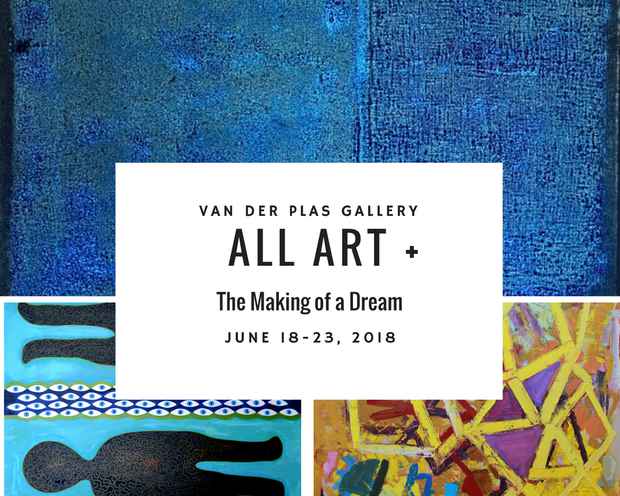“All Art +: The Making of a Dream” Exhibition
Van Der Plas Gallery

This event has ended.
Van Der Plas Gallery presents All Art + group show, The Making of a Dream. In this show, we ask what it takes to make a dream become reality. Is it curiosity, opportunity, or hope that diverse ideas would find acceptance where they might not have before. The Making of a Dream aims to exhibit and explore the labor exerted to foster a dream.
As before, this iteration of our group show brings together old standouts from the Lower East Side as well as newcomers from far-away places. Fred Gutzeit’s paintings will be familiar to gallery regulars; here he presents jewel-toned watercolors loaded with sly references to nature, handwriting, and twentieth-century masterworks (how did Mondriaan and Charles Demuth get in here?). Sally Eckhoff shows up again with another portrait of a misbehaving owl. A remarkable newcomer, Tamar Tateladze, comes from Georgia in Eurasia. She brings startling tableaux of humans and creatures that confront the viewer with steady stares. There’s a sweetness to these paintings, and yet they bring to mind Georges Franju’s spooky movie, “Eyes Without A Face.” Tateladze could be one to watch: she’s certainly watching you.
It’s tempting to call Alex Monshaw’s three vertical black panels an adventure in materials, but that would be missing the point. These oddly luminous wood rectangles manage to evoke the mad sparkle of Joseph Stella’s painting of the Brooklyn Bridge, while at the same time recalling Jay de Feo’s Rose painting made exclusively (and obsessively) of only white paint. “It took me about two years to complete because the painting features three kinds of wood stain, thirteen different acrylic paints, four oil paints, and five kinds of ink,” Monshaw says, adding that his purpose is “taking all of the black and poisonous parts of the soul and repurposing them, taking away their agencies and making something beautiful with the pain they create. So many kinds of black to choose from.”
After this, Eduardo Terranova’s shimmering “Midnight in Paris” comes seemingly out of nowhere. Nowhere, in this case, is a real place called Cali, in Colombia, “a country that has been over fifty years in an internecine war,” in the artist’s words. Terranova, who has an MFA in architecture from the Rhode Island School of Design, describes his method as a process of destroying and constructing his own canvases by hand-stitching and then applying metallic paint. Up close, his surfaces look like boiling volcanic glass; from several steps away they resemble ordered concentrations of stars.
Shinto Imai’s captivating color-field painting, “Screen,” is a real treat, bringing a high level of intensity to a small (about nine inches square) canvas with an opening that seems to hover over its bright red field. This is the screen referred to in the title, a permeable square-within-a-square made of impasto dots in various colors. It’s impossible to see through, of course, but the sense of space on the other side of the veil makes it hard to look away.
Beyond these, the works range from the absurd (Tone Tank’s pizza assemblage) to the antiquarian (Richard Laurenzi’s amphora vessel).Phil Capobianco’s otherworldly sculptures, Tuber #5 and Predator, resemble a deep sea carnivorous plant. Muted colors contrasted with an enticing splash of shimmering blue, create predator and prey scenario. There’s also a welcome detour through abstract expressionism by the French painter Alevito, whose “Picking Up Pieces” and “Emotions” serve as a reminder that this historic school of painting is all but exhausted. Her gestures bring heat to the genre (which has been intellectualized to the point of mummification). This is “painting without fear,” as the artist says—a rescue attempt and a devastating stroke all in one.
Similarly, Dave Jones seems to be killing painting and saving it at the same time: stealing a raw, gestural method straight out the 1940s and making it stand for a contemporary emotional rollercoaster. The effect is less familiar than you’d think, and the casual edges and raw textures add up to an irresistible pull.
In the midst of all of this, Elisabeth Gineste, a.k.a. Stielle, delivers a gulp of pure joy. This native Swiss artist explains that her nom de pinceau comes from a small but ingenious bird, the nuthatch, which can climb down a tree head first—a stunt which, metaphorically, artists do every day. Her paintings of women have a genuine bittersweetness and resignation that give them a sense of being loved. That’s no small feat, however casually the message is delivered. Terrie Powers’s pieces are unambitious, almost unobtrusive: a swimming turtle admiring a pair of hibiscus flowers and an arj overseen by a descending dove bearing an olive branch.
Finally, it’s a pleasure to encounter an avowedly anti-elitist artist in Elliot Avis, whose ceramic piece, “Fountain,” evokes both a Marcel Duchamp masterpiece and Donald Duck flat on his back. It’s a brave statement—all of them are—and we invite each viewer to try to imagine changing places with each artist and imagine what inspired them to announce themselves the way they do.
All Art+: The Making of a Dream presents artists from different backgrounds with one thing in common: making their dreams become a reality. Georges Braque said of Picasso, whom he saw every day in Paris, that because of their painting life they were like two men roped together on a mountain. The act of painting is always an adventure, and should only be undertaken in the spirit of peering down the slope. Join us at Van Der Plas Gallery as we celebrate the bravery in pursuing one’s dreams.
Media
Schedule
from June 18, 2018 to June 23, 2018
Opening Reception on 2018-06-20 from 18:00 to 20:00